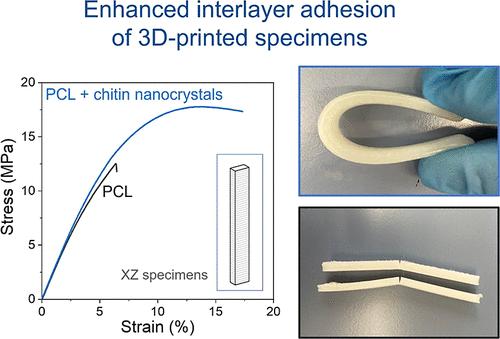当前位置:
X-MOL 学术
›
ACS Appl. Mater. Interfaces
›
论文详情
Our official English website, www.x-mol.net, welcomes your feedback! (Note: you will need to create a separate account there.)
Chitin Nanocomposites for Fused Filament Fabrication: Flexible Materials with Enhanced Interlayer Adhesion
ACS Applied Materials & Interfaces ( IF 8.3 ) Pub Date : 2024-06-28 , DOI: 10.1021/acsami.4c06358 Alberto Sanz de León 1 , Jose A. Pulido 1 , Natalia Fernández-Delgado 1 , Francisco J. Delgado 1 , Sergio I. Molina 1
ACS Applied Materials & Interfaces ( IF 8.3 ) Pub Date : 2024-06-28 , DOI: 10.1021/acsami.4c06358 Alberto Sanz de León 1 , Jose A. Pulido 1 , Natalia Fernández-Delgado 1 , Francisco J. Delgado 1 , Sergio I. Molina 1
Affiliation

|
In this work, we present a series of nanocomposites for Fused filament fabrication (FFF) based on polycaprolactone (PCL) and chitin nanocrystals (ChNCs). The ChNCs were synthesized by acid hydrolysis using HCl or lactic acid (LA). The approach using LA, an organic acid, makes the ChNCs synthesis more sustainable and modifies their surface with lactate groups, increasing their compatibility with the PCL matrix. The ChNCs characterization by X-ray diffraction, Fourier transform infrared spectroscopy, scanning electron microscopy, and transmission electron microscopy revealed that both ChNCs presented similar morphologies and crystallinity, while differential scanning calorimetry and thermogravimetric analysis proved that they can bear temperatures up to 210 °C without degrading, which allows their processing in the manufacturing of PCL composites by twin-screw extrusion. Therefore, PCL composites in the form of filaments containing 0.5–1.0 wt % ChNCs were produced and used as feedstock in FFF, and standard tensile and flexural specimens were printed at different temperatures, up to 170 °C, to assess the influence of the ChNCs in the mechanical properties of the material. The tensile testing results showed that the presence of ChNCs enhances the strength and ductility of the PCL matrix, increasing the elongation at break around 20–50%. Moreover, the vertically printed flexural specimens showed a very different bending behavior, such that the pure PCL specimens presented a brittle fracture at 7% strain, while the ChNCs composites were able to bend over themselves. Hence, this work proves that the presence of ChNCs aims to improve the interlayer adhesion of the objects manufactured by FFF due to their good adhesive properties, which is currently a concern for the scientific community and the industrial sector.
中文翻译:

用于熔丝制造的甲壳素纳米复合材料:具有增强层间粘合力的柔性材料
在这项工作中,我们提出了一系列基于聚己内酯(PCL)和甲壳素纳米晶体(ChNC)的用于熔丝制造(FFF)的纳米复合材料。 ChNCs 通过使用 HCl 或乳酸 (LA) 的酸水解合成。使用 LA(一种有机酸)的方法使 ChNC 的合成更加可持续,并用乳酸盐基团修饰其表面,从而提高其与 PCL 基质的相容性。通过 X 射线衍射、傅里叶变换红外光谱、扫描电子显微镜和透射电子显微镜对 ChNC 进行表征,表明两种 ChNC 具有相似的形貌和结晶度,而差示扫描量热法和热重分析证明它们可以承受高达 210 °C 的温度。且不会降解,因此可以通过双螺杆挤出加工 PCL 复合材料。因此,生产了含有 0.5-1.0 wt% ChNC 的长丝形式的 PCL 复合材料,并将其用作 FFF 的原料,并在高达 170 °C 的不同温度下打印标准拉伸和弯曲样本,以评估 ChNC 的影响在材料的机械性能方面。拉伸测试结果表明,ChNC 的存在增强了 PCL 基体的强度和延展性,使断裂伸长率增加了 20-50% 左右。此外,垂直打印的弯曲样品表现出非常不同的弯曲行为,例如纯 PCL 样品在 7% 应变下呈现脆性断裂,而 ChNC 复合材料能够自行弯曲。 因此,这项工作证明,ChNCs 的存在旨在提高 FFF 制造的物体的层间粘附力,因为它们具有良好的粘合性能,这是目前科学界和工业部门所关注的问题。
更新日期:2024-06-30
中文翻译:

用于熔丝制造的甲壳素纳米复合材料:具有增强层间粘合力的柔性材料
在这项工作中,我们提出了一系列基于聚己内酯(PCL)和甲壳素纳米晶体(ChNC)的用于熔丝制造(FFF)的纳米复合材料。 ChNCs 通过使用 HCl 或乳酸 (LA) 的酸水解合成。使用 LA(一种有机酸)的方法使 ChNC 的合成更加可持续,并用乳酸盐基团修饰其表面,从而提高其与 PCL 基质的相容性。通过 X 射线衍射、傅里叶变换红外光谱、扫描电子显微镜和透射电子显微镜对 ChNC 进行表征,表明两种 ChNC 具有相似的形貌和结晶度,而差示扫描量热法和热重分析证明它们可以承受高达 210 °C 的温度。且不会降解,因此可以通过双螺杆挤出加工 PCL 复合材料。因此,生产了含有 0.5-1.0 wt% ChNC 的长丝形式的 PCL 复合材料,并将其用作 FFF 的原料,并在高达 170 °C 的不同温度下打印标准拉伸和弯曲样本,以评估 ChNC 的影响在材料的机械性能方面。拉伸测试结果表明,ChNC 的存在增强了 PCL 基体的强度和延展性,使断裂伸长率增加了 20-50% 左右。此外,垂直打印的弯曲样品表现出非常不同的弯曲行为,例如纯 PCL 样品在 7% 应变下呈现脆性断裂,而 ChNC 复合材料能够自行弯曲。 因此,这项工作证明,ChNCs 的存在旨在提高 FFF 制造的物体的层间粘附力,因为它们具有良好的粘合性能,这是目前科学界和工业部门所关注的问题。






































 京公网安备 11010802027423号
京公网安备 11010802027423号